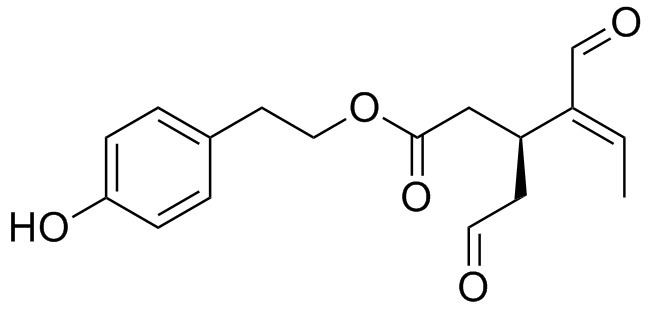Formula C17H20O5 | Molar mass 304.34 g/mol | |
 | ||
Oleocanthal is a phenylethanoid, a type of natural phenolic compound found in extra-virgin olive oil. It appears to be responsible for the burning sensation that occurs in the back of the throat when consuming such oil. Oleocanthal is a tyrosol ester and its chemical structure is related to oleuropein, also found in olive oil.
Contents
Anti-inflammatory
Oleocanthal has been found to have anti-inflammatory and antioxidant properties in vitro. Similar to classical non-steroidal anti-inflammatory drugs, it is a non-selective inhibitor of cyclooxygenase (COX). 50 g (more than three and a half tablespoons) of a typical extra virgin olive oil per day contains an amount of oleocanthal with similar in vitro anti-inflammatory effect as 1/10 of the adult ibuprofen dose. It is therefore suggested that long-term consumption of small quantities may be responsible in part for the low incidence of heart disease and Alzheimer's disease associated with a Mediterranean diet. However, 50 g is a great deal of olive oil for most consumers; moreover, the absorption, metabolism, and distribution of oleocanthal is not well-characterized, and it is not known whether these in vitro effects actually occur in the body. "Against this background, the in vivo anti-inflammatory effects of dietary oleocanthal cannot be as relevant as hypothesized by Beauchamp et al."
Oleocanthal is an activator of the TRPA1 ion channel, which is activated by ibuprofen. This appears to be responsible for the burning sensation when consuming extra-virgin olive oil.
Recently it has been demonstrated that oleocanthal shows potential as a therapeutic agent in the treatment of inflammatory degenerative joint diseases. Oleocanthal inhibits LPS-induced NO production in J774 macrophages, without affecting cell viability. Moreover, it inhibits MIP-1α and IL-6 mRNA expression, as well as protein synthesis, in both ATDC5 chondrocytes and J774 macrophages. Oleocanthal also inhibits IL-1β, TNF-α and GM-CSF protein synthesis from LPS-stimulated macrophages.
Alzheimer's disease
Oleocanthal can reduce the accumulation of β-amyloid proteins involved in Alzheimer's Disease, via up-regulation of P-glycoprotein and LRP1.
Anticancer
Oleocanthal is capable of killing a variety of human cancer cells in vitro while leaving healthy cells unharmed. While apoptosis requires between 16 and 24 hours, oleocanthal operated within 30 minutes to one hour. Oleocanthal pierces cancer cells' lysosomes, the containers that store the cell's waste products, releasing enzymes that kill the cell. In healthy cells, the application of oleocanthal caused a temporary halt in their life cycles, but after 24 hours they returned to normal.
Oleocanthal inhibits the enzymatic activity of mammalian target of rapamycin (mTOR) with an IC50 value of 708 nM. Oleocanthal inhibits the growth of several breast cancer cell lines at low micromolar concentration in a dose-dependent manner. Oleocanthal treatment caused a marked downregulation of phosphorylated mTOR in metastatic breast cancer cell line (MDA-MB-231). These results strongly indicate that mTOR inhibition is at least one of the factors of the reported anticancer and neuroprotective properties of oleocanthal.
